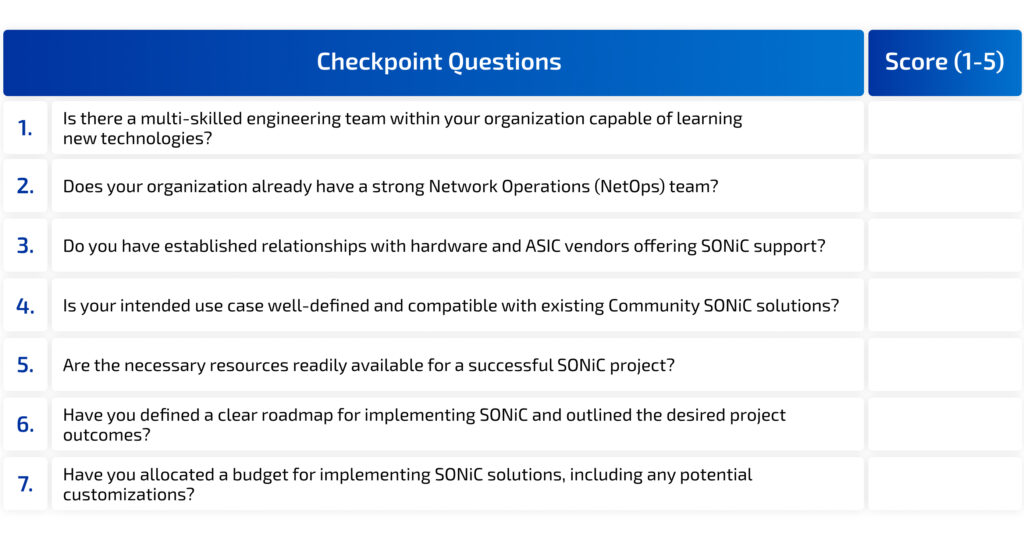SONiC (Software for Open Networking in the Cloud) has gained significant popularity as an open-source Network Operating System (NOS) in data centers. This trend extends to edge and campus environments, driven by hyperscalers’ successful deployments of SONiC, demonstrating its growing adoption across various use cases. For those willing to invest the necessary effort, open networking can offer a level of flexibility, cost-effectiveness, and innovation that proprietary solutions struggle to match. But is SONiC truly an all-or-nothing proposition? Let’s delve deeper.
When SONiC Isn't the Right Choice

Companies should carefully evaluate their readiness before adopting SONiC. The decision has to be based on technical capabilities, resource availability, and long-term networking strategy. Here are 10 reasons not to use SONiC NOS in your network infrastructure:
- 1. Lack of in-house expertise in OSS, particularly SONiC. Unlike proprietary NOS, SONiC is open-source, offering greater control and customization but demanding a skilled team for configuration, optimization, and troubleshooting. This team should be comfortable with Linux, networking protocols, and open-source development. Without them, companies may face challenges like prolonged deployment, suboptimal performance, and network instability.
- 2. No DevOps-friendly internal culture. Traditional network operations struggle with SONiC’s rapid pace. Adopting it might require a cultural shift, involving DevOps practices like automated testing and version control to manage frequent changes and their impact on the network.
- 3. An absence of Quality Assurance (QA) infrastructure. Lacking a robust Quality Assurance (QA) infrastructure, organizations struggle to ensure network stability and security. While diverse networking hardware labs are essential for compatibility and performance testing, automated tools and skilled engineers are needed to analyze results, validate new features, and prevent network disruptions. Furthermore, a shortage of expertise in hardening SONiC exposes organizations to security vulnerabilities due to improper access controls, data encryption, and overall system misconfiguration.
- 4. Uncertain implementation strategy. Understanding network architecture and SONiC’s capabilities is crucial for developing an implementation strategy. Without a well-defined plan, organizations risk disruptive network changes and prolonged outages.
- 5. No operations strategy. Maintaining a SONiC network requires an operations strategy. This can involve building an internal multi-skilled team capable of troubleshooting, patching, and keeping up with the latest developments (requiring ongoing training and resource dedication). Alternatively, commercial support is available but comes with its own costs. Without a solid operations strategy, organizations may face challenges maintaining network stability and resolving issues efficiently.

- 6. Shift in network ownership paradigm. Adopting SONiC represents a departure from traditional approaches. While traditional network operators often prefer working with vendors or system integrators who provide end-to-end solutions, SONiC requires a more active role in network management, from initial design to ongoing operations. If an organization is comfortable with a higher level of ownership and control, SONiC can be a rewarding option.
- 7. Unclear use case and implementation outcomes. Organizations deploying SONiC should thoroughly assess its capabilities against their specific networking requirements. This includes feature sets, performance benchmarks, and scalability considerations. Without a clear understanding of how SONiC will address specific needs, there’s a high risk of wasted resources and an inadequate network solution.
- 8. Limited direct connections with switch and ASIC vendors. SONiC’s reliance on SAI for hardware interaction necessitates collaboration with hardware/ASIC vendors for compatibility. This secures access to crucial drivers and firmware updates but requires dedicated expertise to navigate technical discussions and potentially influence development. Unlike traditional networking, organizations need to actively manage these relationships to ensure optimal performance, avoid support delays, and address low-level issues.
- 9. Unwillingness to collaborate with third parties and communities. Some companies resist cooperating with third parties and the broader SONiC community due to time constraints or an unwillingness to engage with external resources. However, going it alone can lead to missed opportunities for improved compatibility, continuous development, security updates, and adoption of best practices. If you’re hesitant about collaborating, experienced partners like PLVision can assist with planning, deployment, ongoing maintenance, and provide SONiC-based solutions.
- 10. Incomplete Understanding of Total Cost of Ownership (TCO). While SONiC eliminates licensing fees, a thorough TCO analysis is crucial. Estimate potential expenses like personnel training, custom development, integration costs with existing infrastructure, and potentially commercial support depending on your use case and chosen implementation strategy.
Overall, while implementing SONiC is a critical decision, it unlocks significant advantages for organizations ready to embrace open networking.
What Your Business Gets in Return from SONiC Deployment in Network


Customization

Freedom from Vendor Lock-In

Open-Source Talent Pool and Solutions

Collaborative Environment and Time to Value
It’s crucial to understand that open-source SONiC is not free in terms of required resources. The responsibility for tasks traditionally handled by proprietary vendors partially now falls on you. Are you prepared to invest the resources to manage this more hands-on approach?
SONiC Readiness Questionnaire
This questionnaire is designed to assess an organization’s readiness to implement SONiC in their network infrastructure. It covers 7 key areas that are critical for successful SONiC adoption.
Answer each question honestly, assigning a score:
5 – strongly agree,
4 – agree,
3 – not sure,
2 – disagree,
1 – strongly disagree.
Sum up the scores to get your total. This will help you gauge your overall readiness for SONiC implementation and identify areas that may need improvement before proceeding.

Total Score: _____ / 35
Decision Points:
- 0-15: Perhaps SONiC isn’t the best fit at this time – Your organization is not currently prepared for SONiC implementation. Remember, even open-source solutions require significant investment in resources and expertise for successful deployment and ongoing management.
- 16-29: You are ready to explore SONiC, and PLVision can be your partner in the transition – Your organization has some readiness for SONiC, but there are areas that need improvement. Consider partnering with experts like PLVision to fill gaps and guide your implementation to get success.
- 30-35: Can we give you a call when you run into a SONiC issue? – While your organization is well-equipped to implement SONiC independently, partnering with us can unlock even greater benefits. We’re confident that together, we can achieve remarkable results.
Note: This questionnaire is a simplified tool. It doesn’t capture every nuance of your organization’s situation. Use it as a starting point for discussions and further analysis, not as the sole decision-making factor. Also, we recommend exploring a breakdown of the Total Cost of Ownership (TCO) for both proprietary and open-source solutions.
Considering a switch to open-source networking?
Explore the reasons to choose an open-source NOS like SONiC, along with a breakdown of the Total Cost of Ownership (TCO) for both proprietary and open-source solutions.
Conclusion
While SONiC offers significant advantages, it requires careful consideration before deployment. If you’re unsure about your SONiC readiness or require expert guidance, PLVision can help. We offer a comprehensive range of services, including:
- SONiC-based custom product development
- SONiC hardened image for Data Center
- Custom SONiC-based distributions for Telco use case
- Porting Community SONiC to your hardware
- SONiC Lite, a lightweight distribution for management and access switches
Leveraging a collaborative approach, PLVision understands specific needs and tailors open networking solutions, empowering clients to prioritize core business activities.
Contact Us to Discuss Your SONiC Implementation Goals
- 10 Reasons NOT to Deploy
SONiC NOS in Your Network - July 12, 2024 - Choosing the Right SONiC Version for Your Network Infrastructure - May 15, 2024
- SONiC-DASH: Integration for a DPU in 4 Steps - January 23, 2023



